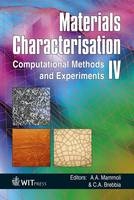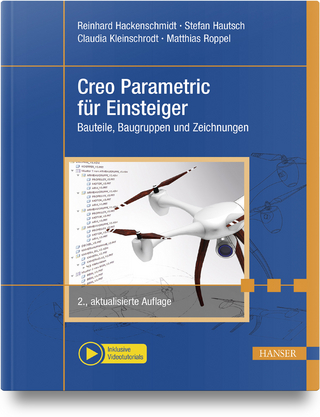
Materials Characterisation
WIT Press (Verlag)
9781845641894 (ISBN)
- Keine Verlagsinformationen verfügbar
- Artikel merken
Until recently, engineering materials could be characterised successfully using relatively simple testing procedures. As materials technology advances, interest is growing in materials possessing complex meso-, micro- and nano-structures, which to a large extent determine their physical properties and behaviour. The purposes of materials modelling are many - optimisation, investigation of failure, simulation of production processes, to name a few. Modelling and characterisation are closely intertwined, increasingly so as the complexity of the material increases. Characterisation, in essence, is the connection between the abstract material model and the real-world behaviour of the material in question. Characterisation of complex materials therefore may require a combination of experimental techniques and computation.This book contains papers from the Fourth International Conference on Computational Methods and Experiments in Materials Characterisation which brought researchers who use computational methods, those who perform experiments, and of course those who do both, in all areas of materials characterisation, to discuss their recent results and ideas, in order to foster the multidisciplinary approach that has become necessary for the study of complex phenomena.
Section 1: Computational models and experiments Identification of material properties of FRC using coupled modeling; A micromechanical model and numerical simulation of framework interstice concrete; Optimization of a numerical model of three-dimensional heat transfer during friction stir welding of 304L stainless steel; ANN Model to predict the bake hardenability of Transformation-Induced Plasticity steels; Transient and steady-state heat conduction analysis of two-dimensional functionally graded materials using particle method; A unique computational algorithm to simulate probabilistic multi-factor interaction model complex material point behavior Section 2: Mechanical characterisation and testing Evaluation of dynamic connection designs for road safety barriers; Characterization of dynamic tensile and shear strength of safety bolts in light collision safety devices of a train; Mechanical properties of a baseline UHPC with and without steel fibers; A rheological comparison of hard grade binders with polymer modified bitumen under aged and unaged conditions; Probabilistic model and experimental identification of screw-attachment in plasterboard; Use of copper slag as a replacement for fine aggregate in reinforced concrete slender columns; Characterization of field-dependent elastic modulus and damping in pure nickel and iron specimens using a new experimental system; Experimental determination of representative elementary volume of sands using X-ray computed tomography; Short-time test for evaluating the machinability of alloys; Dynamic shear stress in a double lap bonded assembly; High velocity impact of carbon composite plates: perforation simulation; The effect of bent-up tab shear transfer enhancement shapes, angles and sizes in precast cold-formed steel-concrete composite beams; Material phase transformations due to shock wave loading in contact geometry Section 3: Materials characterisation and testing Experimental and theoretical investigation of the microstructural evolution in aluminium alloys during extrusion; Fracture toughness KIC of cemented carbide WC-Co; Characterisation of natural Zeolite and the feasibility of cations and anions removal from water; Resonant ultrasound spectroscopy for investigation of thin surface coatings; The effect of cerium solutions on 316L stainless steel; Image analysis application in metallurgical engineering and quality control Section 4: New methods Ultra-high-performance fiber reinforced concrete: an innovative solution for strengthening old R/C structures and for improving the FRP strengthening method; Improvement in wear resistance of TiNi alloy processed by equal channel angular extrusion and annealing treatment; Tunnelling measurements as a new method of investigation of thin film superconducting cuprate junctions Section 5: Advanced materials Synthesis, characterization and bioactivity evaluation of nano-structured hydroxyapatite; Evaluation of ABS patterns produced from FDM for investment casting process; Thermoelectric effect in quantum wells and hetero-structure; Investigation of performance properties of novel composite fire-extinguishing powders based on mineral raw materials Section 6: Cements Experimental confirmation of some aspects of the microstructural model of the impedance spectra of porous materials; Modelling of the elastic parameters development of an oilwell cement paste at a very early age under downhole conditions; Performance of concrete containing high volume coal fly ash - green concrete; Influence of curing conditions on the mechanical properties and durability of cement mortars Section 7: Porous construction materials Microstructural characterisation of porous construction materials - major challenges; Surfology: concrete surface evaluation prior to repair; Development of new approaches to moisture content measurement for building materials; Cement-based composites for structural use
| Erscheint lt. Verlag | 10.6.2009 |
|---|---|
| Reihe/Serie | WIT Transactions on Engineering Sciences ; No. 64 |
| Zusatzinfo | Illustrations |
| Verlagsort | Southampton |
| Sprache | englisch |
| Maße | 155 x 230 mm |
| Themenwelt | Informatik ► Weitere Themen ► CAD-Programme |
| Technik ► Maschinenbau | |
| ISBN-13 | 9781845641894 / 9781845641894 |
| Zustand | Neuware |
| Informationen gemäß Produktsicherheitsverordnung (GPSR) | |
| Haben Sie eine Frage zum Produkt? |
aus dem Bereich


